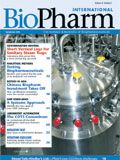Operations Excellence: Managing Your Suppliers for Maximum Results
Better supplier management can begin in parallel to production-related improvements.
Operations Excellence, as applied most often in biopharmaceutical organizations, focuses almost entirely on internal manufacturing and quality operations. This is the right place to start; manufacturing effectively is the key to producing quality product on time.

Marc Puich
However, once the quick wins are achieved in the plant, where should organizations look next for continuous improvement opportunities? The next logical place is upstream with the suppliers.
As a result, the topic at the most recent Operations Excellence Consortium meeting, held July 22 at Bayer Biologicals in Berkeley, CA, was highly relevant to Operations Excellence programs: Supplier Quality Management.
In highly competitive, commodity industries that have perfected Operations Excellence practices, material costs can compose more than 50% of the overall product costs. Additionally, profit margins can be so small that poor production yields can significantly impact the bottom line. As a result, Operations Excellence programs in those industries have applied Operations Excellence practices aggressively with their suppliers.
Some examples of supplier management practices at world-class organizations include:
- Supplier integration: Toyota and other auto manufacturers set aside space within their own facilities for the vendors to produce components for their cars, eliminating transport from the supply chain and providing real-time feedback on quality issues.
- Data integration: Demand signals are transmitted electronically in real time to suppliers, providing the most accurate order and forecasting information and reducing inventory backlogs.
- Supplier consulting: GE and Hewlett-Packard provide "free" consulting to their key suppliers. This results in lower costs and higher quality incoming materials.
- Development integration: Key suppliers take an active role in shaping the future product portfolio, combining their specific expertise with that of the customer companies to produce more cutting-edge products.
When compared to those companies, the biopharmaceutical industry is relatively unsophisticated in dealing with suppliers. Some of the reasons for this were covered in the most recent consortium meeting, and include:
- Lack of trust: Manufacturing products for human consumption demands a focus on patient safety. Most companies in the industry have dealt with suppliers changing processes without notification or supplying out-of-specification product. Because of this lack of trust at the supply base, the industry routinely requires 100% testing inspection of incoming materials, an expensive and time-consuming activity. Additionally, regular auditing of their supplier facilities are mandated by FDA regulations.
- Problem of Scale: Biopharmaceutical companies consume relatively small volumes of raw materials compared to their suppliers' other customers. As a result, working to drive higher quality upstream or asking for better raw material specifications has normally fallen on deaf ears.
- Not-Invented-Here Mindset: It is true that the leading biopharmaceutical companies invented the main processes for making drug substance today. However, vendors who support the industry have developed expertise that may be significant to their customers; however, R&D groups may not be open to soliciting vendor advice on future product development.
These may seem like significant challenges, but companies have found ways to circumvent these issues or minimize their impact:
- Reducing the number of suppliers to allow better vigilance of their operation and closer management of their supply chain.
- More robust auditing that examines not just the supplier, but the supplier's supplier.
- In larger firms, a clear process for receiving change notices from suppliers and assuring a proper evaluation and response.
- Paying a premium for raw materials with tighter specifications. To guarantee higher quality, companies can work out special deals with vendors to source products with tighter specifications. In some cases, this means that the vendor may be inspecting 100% to achieve that quality, but that cost is likely incurred in a lower cost area, with lower cost resources, than in your own facility.
- Including procurement in development to ensure that inappropriate vendors are not locked in to the bill of materials.
- Leveraging supplier knowledge, especially in the area of deviation management and reduction.
- Using vendors for noncontrolled materials management, including vendor managed inventory (even in controlled environments) and raw material Kanbans.
- Ongoing, robust measurement of supplier performance. This can be used to shift order volume to higher quality suppliers.
Better supplier management doesn't need to wait for the Operations Excellence program to mature in production. Many of the above identified improvements can begin in parallel to production-related improvements.
However, companies need to face reality: The biopharm industry will not likely reach the production volumes of small molecule producers or companies in other industries for years to come. Until better leverage is achieved, your company will need to put in extra effort and management to minimize supplier risk to quality and delivery.
CONSORTIUM UPDATE
The latest East Coast consortium meeting was held August 22 at Human Genome Sciences in Rockville, MD. The meeting was well attended and focused on the challenges of moving a new plant from qualification to commercial development. The session included a tour of the new large scale facility. The next European Consortium is scheduled for September 26 at Avecia in the UK. Go to www.tefen.com/bio for information on past and future meetings.
Marc Puich is a partner at Tefen, Ltd., 1065 E. Hillsdale Blvd., Suite 421, Foster City, CA, 94404; Tel 650.357.1120 x117, Fax 650.372.1350, marc@tefen.com

VERAXA and Voyager to Create Combined Business for Advancing Pipeline of Next-Gen Cancer Therapies
April 23rd 2025The proposed business combination would create a publicly traded, clinical-stage biopharmaceutical company that will focus on developing a pipeline of next-generation cancer therapies.
MHRA Approves GSK Therapy Combinations for Multiple Myeloma
April 21st 2025Belantamab mafodotin is approved in combination with bortezomib plus dexamethasone in patients who have had at least one prior therapy, and in combination with pomalidomide plus dexamethasone for those who have had a prior therapy including lenalidomide.
Tokyo University of Science Research Team Explores Improved Delivery of Antisense Oligonucleotides
April 18th 2025Using cholesterol-modified oligonucleotides, the research team aims to improve the delivery of antisense nucleotide-based therapies for treating neurodegenerative diseases and brain cancers.